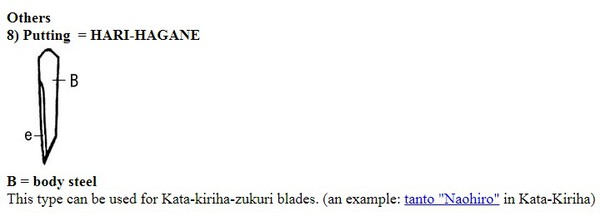-
Posts
1,691 -
Joined
-
Last visited
-
Days Won
11
Content Type
Profiles
Forums
Events
Store
Downloads
Gallery
Everything posted by Dave R
-
I have a little more information now on this one, having taken it to two different meeting of knowledgeable Nihonto collectors. The nakago is apparently distinctive of Kaga blades, though the blade is more Hizen. Which possibly explains something else.... It appears to have been signed, and the signature then carefully removed. The conclusion is that it had been judged to be Gimei, and then "corrected". This probably also explains the scrubbed nakago. I need a much better camera to take photos worth sharing, but I can now say that it has a suguha hamon, of a healthy 6 to 7 mm in depth all the way along the blade. Not a connoisseurs blade, but a good healthy piece that I am happy with.
-
I think the same.
-

Kyu-Gunto Opinion And Translation Request
Dave R replied to zook's topic in Military Swords of Japan
It gets worse. I think the mounts are modern, as in replica, and a genuine blade ground to fit. -

Notches On Nakago—What Are They?
Dave R replied to Navymate's topic in General Nihonto Related Discussion
I wonder when the second Mekugi-ana was put in? -

Mismatched Officer's Gunto And Saya Or...?
Dave R replied to kotkinjs1's topic in Military Swords of Japan
Entirely a matter of personal opinion and wishes, there are a lot of orphan blades and fittings out there..... And you would be surprised at how many shotgun jobs are on Ebay, and dealers tables. And much better than buying/investing in an outright fake! -
Due to paper being a bit soft, and absorbent I would try a metal foil like aluminium or copper foil first..... Or even cut a seppa from bamboo leaf which I understand to be one traditional solution.
-
Traditionaly Photo's would be good.
-
Generally any Japanese sword is a tight fit, and has an even number of seppa. What you describe sounds like the sword has suffered from shrinkage in the organic parts of the mounts, or is a mismatch in some way... However, I think an Emura signed blade can get a pass on the odd issue.
-

Mismatched Officer's Gunto And Saya Or...?
Dave R replied to kotkinjs1's topic in Military Swords of Japan
It's a shotgun job, with a very dodgy tsuba and kabutogane. If it's cheap enough, it just might, but only just might, be worth buying as a project. -

Build Quality Of A Nihonto By Sight
Dave R replied to fatrat2's topic in General Nihonto Related Discussion
I suggest looking for clean and confident lines. No wobbles or dips, the edge an even curve, and clear signs of the hamon relating to the edge. Are these lines continued into the nakago, is the filing on it clear and parallel, and does it end in a neat and clean manner. Look at as many swords in hand as you can. Books are good, reading is essential, but nothing beats looking at a lot of real swords held in the hand. -
Just a thought, but could it be a result of the construction... Hari Hagane, sometimes referred to as "kitchen steel" ?
-
I have seen a fair few stripped blades on dealers tables here in the UK, and bought them as well. Why do they get stripped? Sometimes the mounts are so shattered that they are dumped... sometimes so good that they get transferred to a "better" blade to make a more saleable package. Or just sold separately if the blade is considered dubious in some way. Sometimes the fuchi/kashira are considered more saleable on their own, and the same for menuki. Once they are gone from the koshira, and the ito cut off, it soon falls apart. In other words, they get stripped and orphaned to facilitate dealers making a quick sale, or a better profit. More common in the past than now, but possibly still goes on.
-
My first thought as well.
-
I have seen it referred to colloquially as a Bull(s) Head kissaki. Traditionally it supposedly came in after the Mongol invasion during which a lot of Tachi had their points broken in combat. I have also heard it referred to as an armour piercing point, but I am not too sure on that one. I will be interested to see what more knowledgeable people post on this.
-
That is a rather excellent piece indeed...... signed and dated?
-
Generally speaking Riinji Seishiki, aka type 3's with RJT blades had lacquered wooden scabbards. Usually lacquer over paper or fabric glued to the wood. I think you are missing a Haikan and an Ishizuki rather than a field cover. Saya that were meant to have covers were usually unfinished in any way, or had a quick and dirty coat of black lacquer usually faded now to brown. http://ohmura-study.net/753.html
-
I see issues with the above linked piece. 'Nuff said.
-
You even see them on factory blades....... There is some discussion elsewhere on this site.
-
I see a couple of conflations here. The first is lumping together blades that never were signed, with those that had their signature removed. The other is collectable value being considered the same as commercial value and vice versa. Just my two pennyworth .
-
A little illumination here.... http://www.ksky.ne.jp/~sumie99/ubumumei.html
-
And none of those latches are on the mune. That sort of latch position is pretty diagnostic of coming from an NCO sword.
-
Which means a Showa-To and so made no later than the end of the war!
-
A brass tsuka!No other evidence needed.




